
by Jennifer Burden | Aug 5, 2014 | 2014, Awareness, Education, Humanitarian, Older Children, Save The Children, Social Good, Social Media, World Moms Blog, World Voice, Younger Children

World Moms Blog is thrilled to be taking part in Save the Children‘s #FindTheWords campaign. The campaign raises awareness over 30 days with 30 words to emphasize that every child needs early education to thrive. The community of mothers that form World Moms Blog are committed to improving not just the lives of our own children, but of all children around the world.
Just by helping us spread the word by sharing on social media you will be entered to win a $100.00 gift card!
CREATE
The inspiration word we were given by Save the Children for this post was “create.”
We believe in creating the world we want to live in, here, at World Moms Blog. When I was looking to find a one-stop-place to read about mothers in different cultures and countries back in 2010, I couldn’t find what I was looking for. So on a whim, I decided to create the site I wanted to follow, just for fun.
In turn, the web site led me to new corners of the globe for social good and to meet my fellow World Moms, raised awareness for global health programs for women and children, created various international journalistic opportunities and fellowships for our contributors, and connected many very different women whom, otherwise, may have never connected, but are so glad they did!
Today, World Moms Blog writes from over twenty different countries spanning the globe, yet, we’ve found that mothers from such diverse places all want the same things for their children: health, peace, education, and security. We all want to see our children thrive and grow to their full potential.
There is an incredible sense of pride in creating something, whether you are a child creating a “masterpiece” or a mom creating the family financial plan. In creating World Moms Blog, I have had the opportunity to see many of our contributors run wild with their passions across our pages and witness our editors build our behind-the-scenes in managing over 60 volunteer contributors. That’s creation gone wild, and I love it!
With the help of the women who were part of writing and/or later embraced our mission statement, our site has blossommed into a tight-knit, albeit, world-wide community where the contributors and readers alike are able to broaden their worlds and connect over continents…all through the conduit of motherhood.
The word create inspires all we stand for at World Moms Blog. Whether it is to create an opportunity for yourself or for others to thrive globally, to create the life you want to lead, or the world you want to live in.
And we admire the work of Save The Children in creating a safe, healthy space for the children who need it most. Kids are at our heartstrings! Here are some amazing facts about the challenges children face around the globe:
- The first years of life are critical in children’s development, shaping cognitive, social and language skills, as well as lifelong approaches to learning. Evidence shows that 85 percent of brain growth occurs in the first five years of life.
- By age three, children from low-income homes hear on average 30 million fewer words than their peers, putting them 18 months cognitively behind his or her peers when they start school.
- 65% of young kids in need have little or no access to books. More than two-thirds of poverty-stricken households do not possess a single book developmentally appropriate for a child under five.
- Parents who talk less with their children in an engaging and supportive way have kids who are less likely to develop their full intellectual potential than kids who hear a significant amount of child-directed speech.
- Around the world, if all students in low-income countries acquire basic reading skills, 171 million people could be lifted out of poverty.
Help create the future we want for children with Save the Children’s #FindTheWords. Early education creates an environment for young minds to flourish all over the world.
Just by helping us spread the word by sharing on social media you will be entered to win a $100.00 gift card, here are the rules:
To enter share our post via twitter or Facebook or Snap a picture anywhere you see the word “Create” out in the world (or what it means to you) then post it to Facebook, Twitter, or Instagram.
To officially participate, your contributions must be tagged with the proper hashtags
#FindTheWords
#Create
and don’t forget to tag @WorldMomsBlog so we know you are in the running to win!
(The more people who share our posts the better chance we have of winning an interview with actress Jennifer Garner! So what are you waiting for!?)
a Rafflecopter giveaway
This is an original post to World Moms Blog by founder, Jennifer Burden.

Jennifer Burden is the Founder and CEO of World Moms Network, an award winning website on global motherhood, culture, human rights and social good. World Moms Network writes from over 30 countries, has over 70 contributors and was listed by Forbes as one of the “Best 100 Websites for Women”, named a “must read” by The New York Times, and was recommended by The Times of India.
She was also invited to Uganda to view UNICEF’s family health programs with Shot@Life and was previously named a “Global Influencer Fellow” and “Social Media Fellow” by the UN Foundation. Jennifer was invited to the White House twice, including as a nominated "Changemaker" for the State of the World Women Summit. She also participated in the One Campaign’s first AYA Summit on the topic of women and girl empowerment and organized and spoke on an international panel at the World Bank in Washington, DC on the importance of a universal education for all girls. Her writing has been featured by Baby Center, Huffington Post, ONE.org, the UN Foundation’s Shot@Life, and The Gates Foundation’s “Impatient Optimists.” She is currently a candidate in Columbia University's School of International and Public Affairs in the Executive Masters of Public Affairs program, where she hopes to further her study of global policies affecting women and girls.
Jennifer can be found on Twitter @JenniferBurden.
More Posts - Website
Follow Me:


by Elizabeth Atalay | Jul 29, 2014 | 2014, Africa, Ethiopia, Humanitarian, Inspirational, ONE, Social Good, World Moms Blog, World Voice
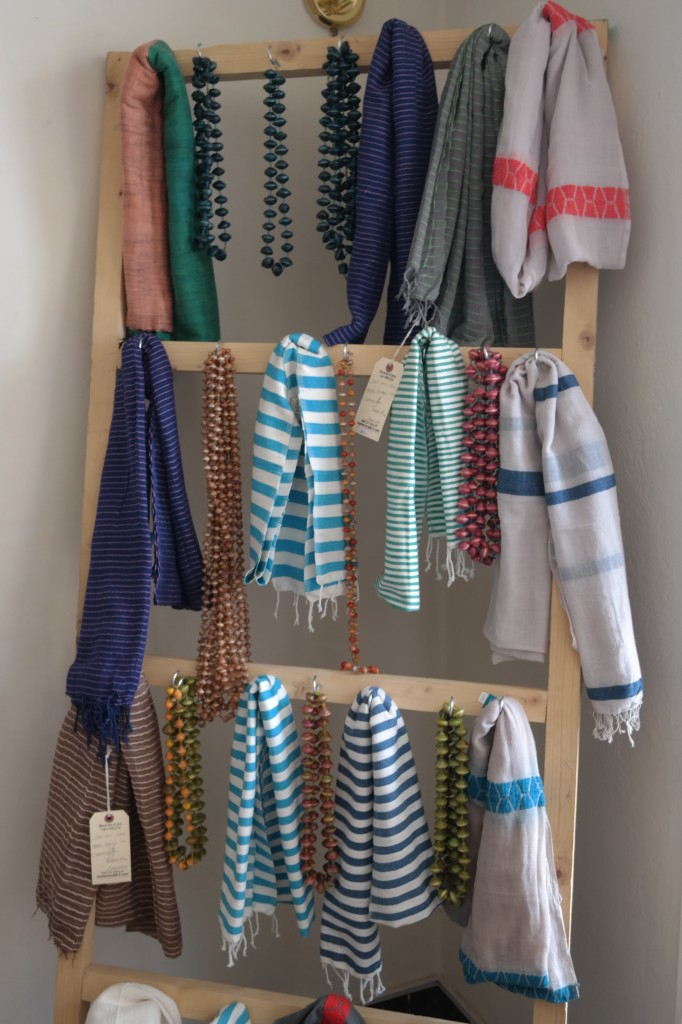
Twenty years ago Cherry had completed her university degree in business, but was still unemployed. Driving with her family one night past the prostitutes on the streets of Addis Ababa she and her family sparked a discussion that left her wondering about what separated her life from theirs. The street women who flashed them as they passed stayed in Cherry’s mind. She was an educated woman who could not find a job, how were these women supposed to find decent jobs if she couldn’t? She began going out at night to speak with the girls on the street and formed relationships that then became the foundation of “Women At Risk”, an NGO providing rehabilitation and job skills training to provide the women with alternate opportunities.
Today “Women At Risk” partners with Ellilta Products where the gorgeous FashionAble scarves that Nicole Melancon and I first heard of through the ONE Campaign are made. We knew if we had the opportunity while in Ethiopia on our International Reporting Project #EthiopiaNewborns New Media Fellowship trip we would love to visit the facility ourselves. Eden Genet Melke, Ellilta’s Business Development Manager was gracious enough to welcome us to the headquarters, show us around, and share the story of how it all began. Forty to forty-six women a year now go through the program of six months of rehabilitation followed by six months of job training. The program has had a 96% rehabilitation rate of women being able to leave behind their life on the streets and create a new future for themselves, and their children.
Cotton has been grown as a crop in Ethiopia as far back as Queen Sheba, and the history of rich textiles are woven into Ethiopian heritage. Initially the women in the program, most of whom are single mothers, were hesitant to learn weaving. In Ethiopia weaving has traditionally been a man’s trade. Most Ethiopian men in the southern region know how to weave, and the women customarily have done the spinning, but once the women saw their finished products with their names on them, (each scarf comes with a name tag signed by the woman who made it) their sense of pride in what they were able to create emerged.
Here is how the process of transformation takes place
Raw Cotton
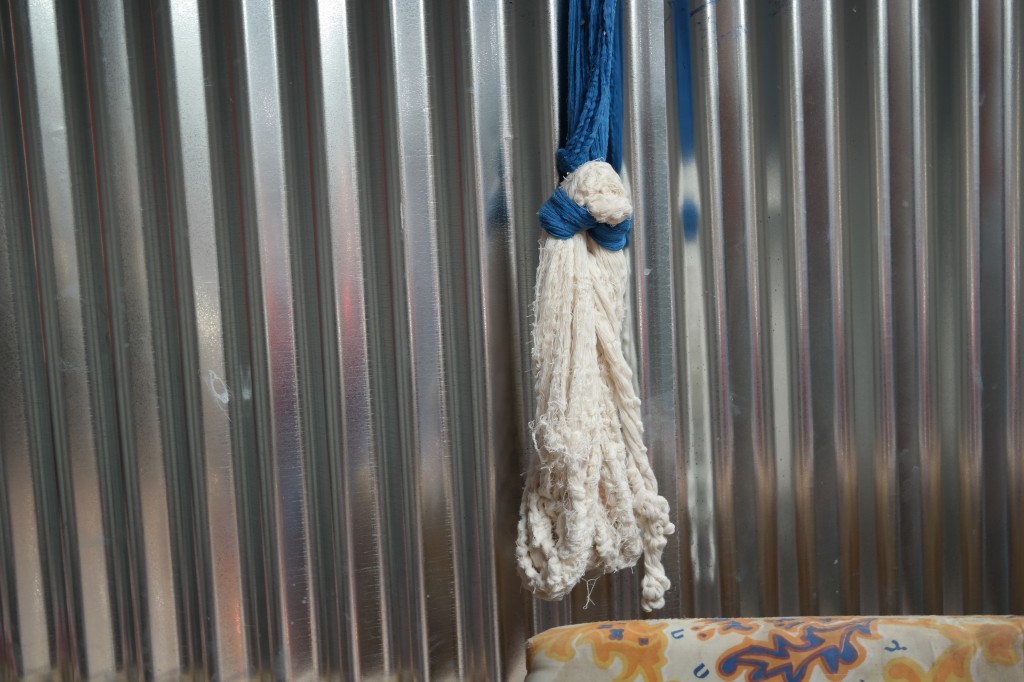
Colorful Dye
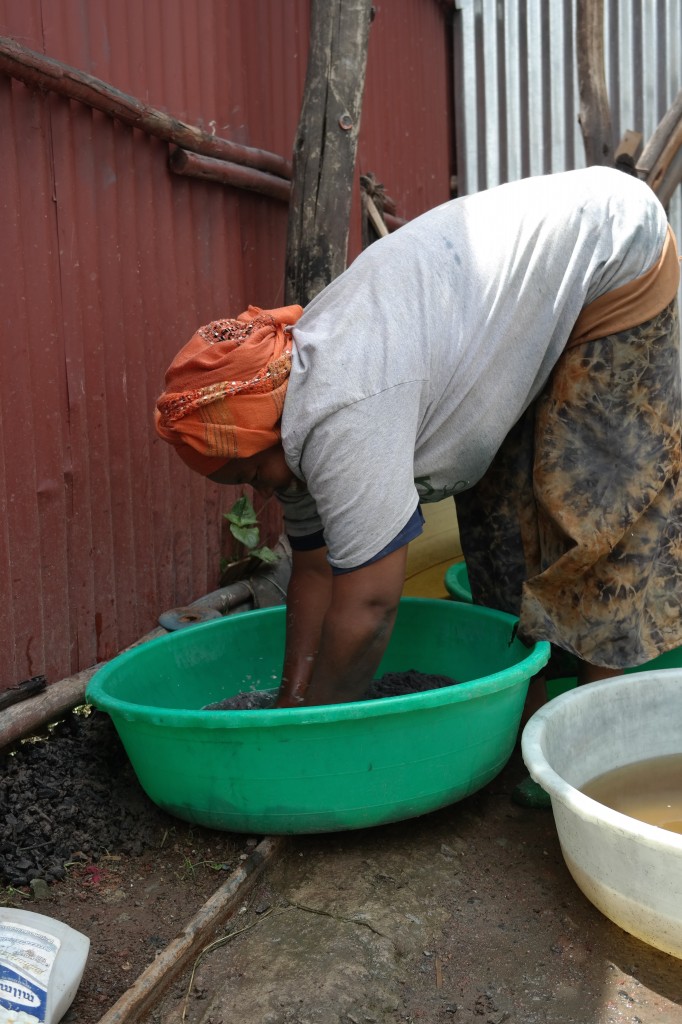
Dried In The Sun
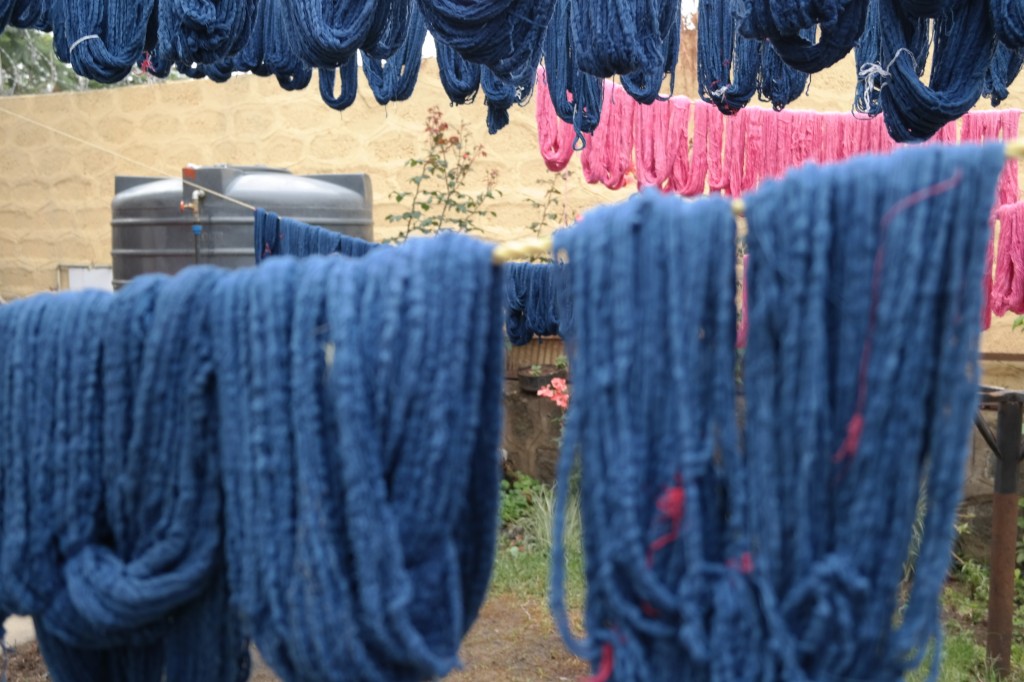
Spun
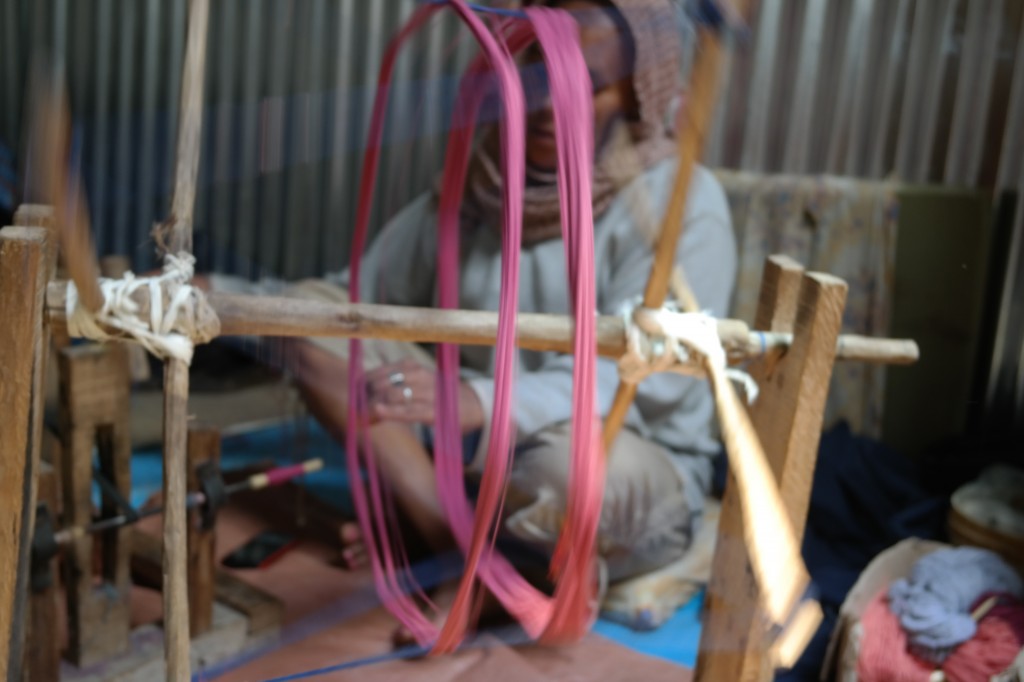
Then Woven Into the Beautiful Creations They Become
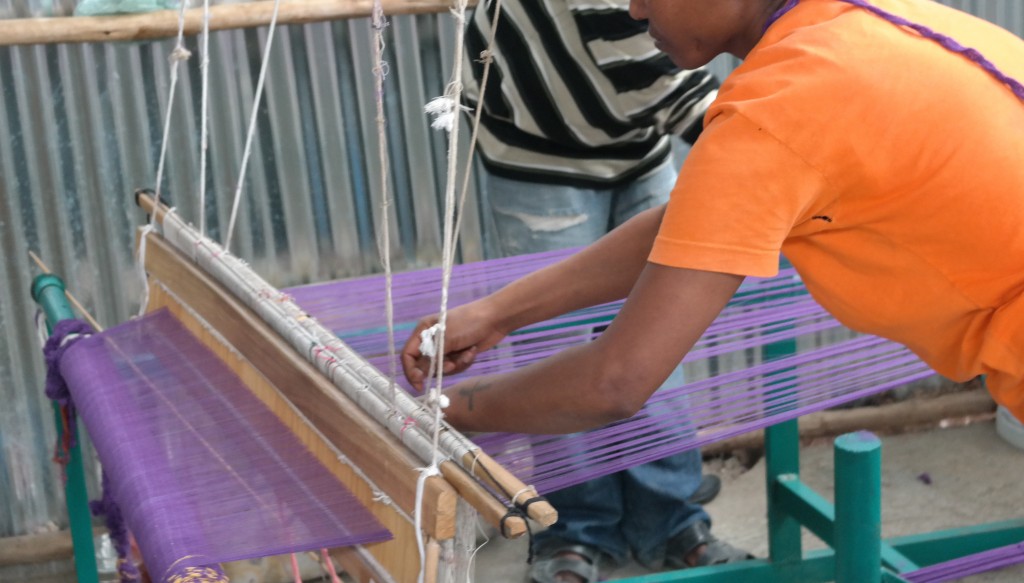
This is an original post written by Elizabeth Atalay of Documama for World Moms Blog
Elizabeth Atalay and Nicole Melancon were in Ethiopia with The International Reporting Project #EthiopiaNewborns New Media Fellowship reporting on newborn health.

Elizabeth Atalay is a Digital Media Producer, Managing Editor at World Moms Network, and a Social Media Manager. She was a 2015 United Nations Foundation Social Good Fellow, and traveled to Ethiopia as an International Reporting Project New Media Fellow to report on newborn health in 2014. On her personal blog, Documama.org, she uses digital media as a new medium for her background as a documentarian. After having worked on Feature Films and Television series for FOX, NBC, MGM, Columbia Pictures, Warner Brothers, 20th Century Fox, and Castle Rock Pictures, she studied documentary filmmaking and anthropology earning a Masters degree in Media Studies from The New School in New York. Since becoming a Digital Media Producer she has worked on social media campaigns for non-profits such as Save The Children, WaterAid, ONE.org, UNICEF, United Nations Foundation, Edesia, World Pulse, American Heart Association, and The Gates Foundation. Her writing has also been featured on ONE.org, Johnson & Johnson’s BabyCenter.com, EnoughProject.org, GaviAlliance.org, and Worldmomsnetwork.com. Elizabeth has traveled to 70 countries around the world, most recently to Haiti with Artisan Business Network to visit artisans in partnership with Macy’s Heart of Haiti line, which provides sustainable income to Haitian artisans. Elizabeth lives in New England with her husband and four children.
More Posts

by Cindy Levin | Jul 1, 2014 | 2014, Economy, World Bank, World Interviews, World Voice
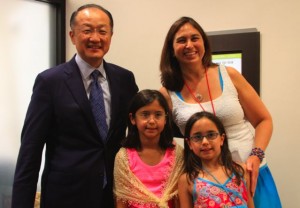
What is the World Bank and what does it do? If you ask an average American, you’ll likely get a blank stare or a wild guess. “Is it like when we played Monopoly as kids and one person got to hand out all the money?” quipped Mackenzie Astin on Vox Populi Radio recently when host Sean Astin tried to explain it to him. “It’s probably where all the countries keep their money,” said my 8-year-old to her sister. Whatever the answer, you’ll usually not hear “they fight poverty” as a first guess, but that’s exactly the key to what an everyday person should know about the World Bank.
While attending the 2014 RESULTS International Conference in June, my daughters and I had a chance to meet World Bank President Dr. Jim Yong Kim moments before he took the stage for an interview in front of hundreds of RESULTS volunteer activists who work every day to end poverty. While we awaited his arrival, I had time to reflect on the role of this man and the World Bank on what kind of world my kids will inherit from my generation.
The World Bank is a United Nations financial institution that provides loans to developing countries. Yet it’s not a bank in the ordinary sense. It’s a partnership that exists to reduce poverty and support development of impoverished nations. Imagine that…a bank with a mission to fight poverty! It provides low-interest loans, interest-free credits, and grants to developing countries to fund programs like education, health, agriculture, and environmental resource management. Where does the money come from? Donor countries, banks, multilateral institutions, and private sector investors all contribute to this vital source of financial and technical assistance to developing countries around the world.
Dr. Kim’s audience cheered wildly that day, holding signs saying “We love the World Bank” because they knew he was going to re-assert the World Bank’s mission end extreme poverty by the year 2030. In fact, the World Bank has set two goals for the world to achieve in that time:
1. End extreme poverty by decreasing the percentage of people living on less than $1.25 a day to no more than 3%
2. Promote shared prosperity by fostering the income growth of the bottom 40% for every country
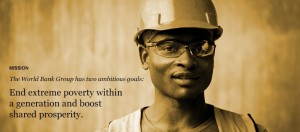
Wow. That’s only 14 years from now. In 2030, my 10-year-old will be 26 years old. Is it possible that in their adulthood, my children could live in a world without extreme poverty? Will they actually have to explain to their children what it was like when millions of people struggled to live on less than $1.25 a day because that kind of suffering won’t be found on the news?
Dr. Kim spoke of his belief that we should focus on the moral imperative to end poverty and shoot for big goals even before we precisely know how to get there. He said our attitude should be “balancing between moral reasoning and the humility that we may not have everything together…but going for it anyway because it’s the right thing to do.” Helping to save lives and educate children is a goal in itself. Plus, evidence for economic benefit of poverty elimination has now caught up with the ethics. For instance, 24% of economic growth is due to better health outcomes. We also now have evidence to show that education is not just nice to have…it’s necessary for growth. So, we should not be afraid to set the incredible goal and then work backward and say, “To achieve our goal, what kind of organization do we need to be to meet that?”
Is Dr. Kim an idealist? Yes, I do think so, but he’s an idealist in the very best way. He has a grand vision of what is possible coupled with a practical leadership style revealed in his insistence on “results based financing.” He wants the World Bank to focus on impact on the ground rather than getting money. When we can report incredible results like a neo-natal mortality drop in Argentina of 74%, donors witness what is possible and invest more.
The path Dr. Kim describes toward the end of extreme poverty is in no way easy. For one thing, it requires confronting the status quo and our assumptions about what works. We need to ask tough questions of organizations providing services, like, “Are you where the poor people are? Are your clinics convenient for you or for the people in poverty who you serve?” The World Bank has a critical role to measure and release regular data about poverty using sophisticated techniques so that we can make great decisions, inspire more funding, and get great results.
In summary, he concluded for us,
“We are not a hard-hearted organization just focused on increased GDP. We are dedicated to ending poverty and making sure that everyone participates.”
All in all, I feel extremely lucky. I feel lucky that I had a chance to meet a man of such vision. I feel lucky that as an advocate for global health and education in this era, I – personally – have a role in bringing about the end of extreme poverty. But most of all, I feel very hopeful and fortunate that if we work together with leaders like Dr. Kim, my daughters will see the end of extreme poverty within their lifetimes and millions more mothers will see their babies grow to be as strong and healthy as mine.
This is an original post written by Cindy Levin for World Moms Blog.
Cynthia Changyit Levin is a mother, advocate, speaker, and author of the upcoming book “From Changing Diapers to Changing the World: Why Moms Make Great Advocates and How to Get Started.” A rare breed of non-partisan activist who works across a variety of issues, she coaches volunteers of all ages to build productive relationships with members of Congress. She advocated side-by-side with her two children from their toddler to teen years and crafted a new approach to advocacy based upon her strengths as a mother. Cynthia’s writing and work have appeared in The New York Times, The Financial Times, the Washington Post, and many other national and regional publications. She received the 2021 Cameron Duncan Media Award from RESULTS Educational Fund for her citizen journalism on poverty issues. When she’s not changing the world, Cynthia is usually curled up reading sci-fi/fantasy novels or comic books in which someone else is saving the world.
More Posts - Website
Follow Me:


by Elizabeth Atalay | Jun 24, 2014 | 2014, Africa, Awareness, Babies, Birthing, Ethiopia, Health, Humanitarian, Maternal Health, Millennium Development Goals, Motherhood, Newborn Health, Pregnancy, Save The Children, Social Good, Third Eye Mom, Travel, World Moms Blog, World Voice
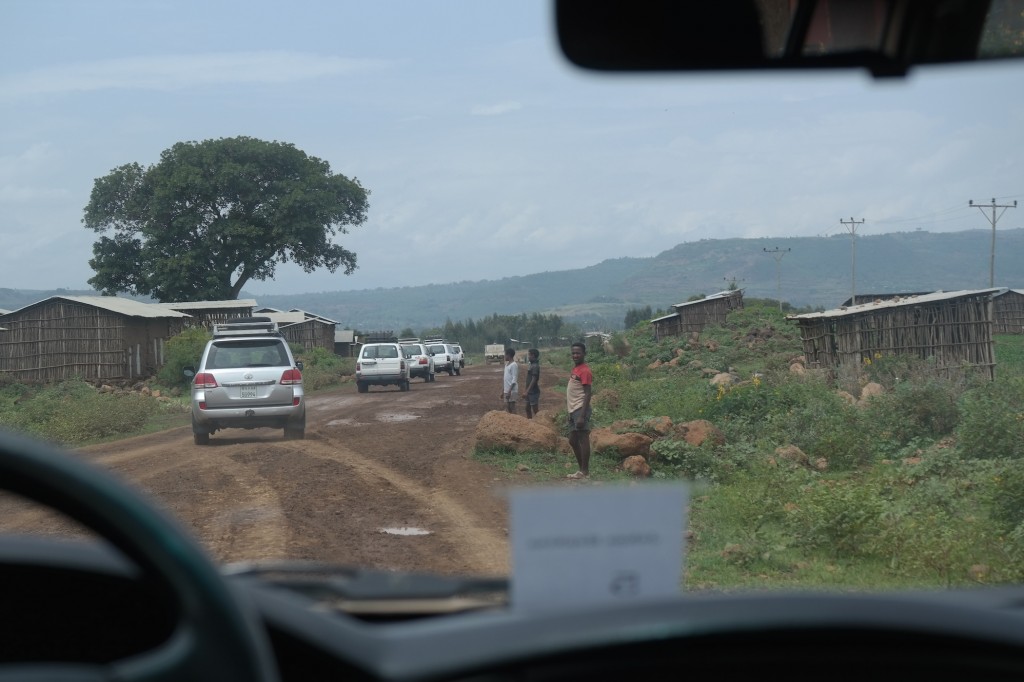
We had just spent the night at the source of the Blue Nile River. Lake Tana sits in Bahir Dar, Ethiopia, and as our caravan of Land Cruisers wove through the countryside from Bahir Dar to Mosebo I took in deep gulping breaths of sweet fresh Ethiopian air. The lush colors of our surroundings looked to me like they had been enhanced in Photoshop in the way that everything seemed to pop. How could I feel this emotional connection to place that was never mine? A place I had never been?
Though this is my first time in Ethiopia, the verdant landscape brought me back to other rural parts of Africa I’d traveled through in my youth, similar topographies that had stayed with me ever since. This time I’d returned to the continent as a new media fellow with the International Reporting Project to report on newborn health. World Moms Blog Editor Nicole Melancon of ThirdEyeMom is a fellow on the trip as well, and last week wrote about our initial overview of maternal and newborn health in Ethiopia. Now we were heading to one of the villages housing a Health Post, which serves the local and surrounding population of approximately 3,500 people.
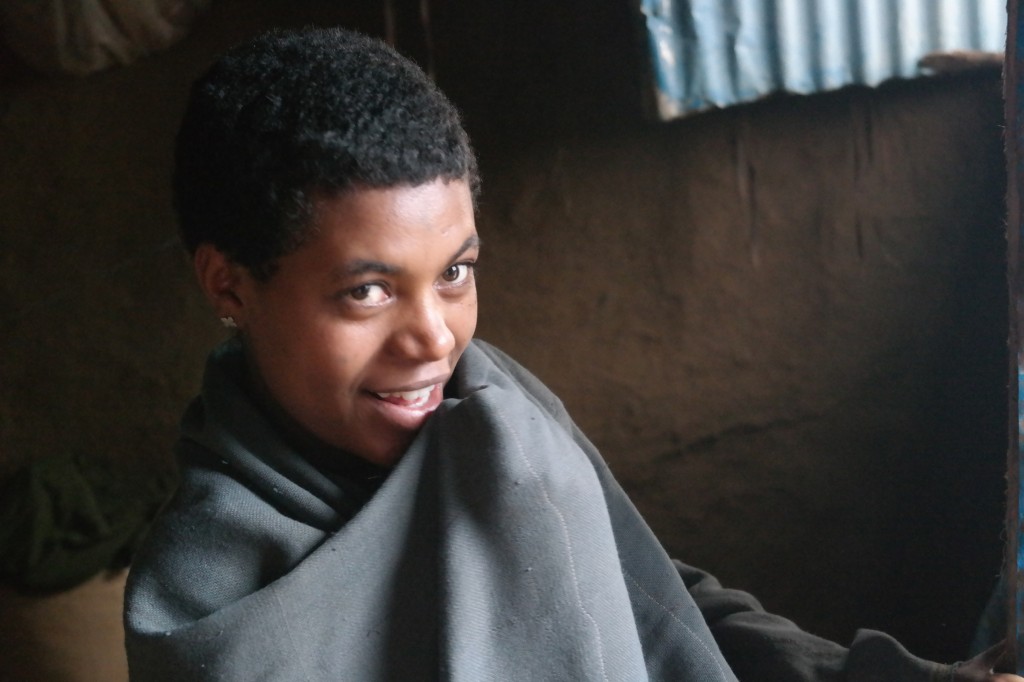
Mosebo Village is part of Save The Children’s Saving Newborn Lives program, and as such is looked to as a model village in the Ethiopian Government’s plan to reduce maternal and newborn mortality. Mosebo is a rural agrarian community that produces wheat, teff and corn. There I met seven-year-old Zina whose mother, Mebrate was about to give birth. Through our translator Mebrate estimated her age to be around 26, and told us that Zina was her first child. For economic reasons she and her husband had waited to have a second. When she had Zina, Mebrate had gone to her parent’s home to give birth, as women in Ethiopia often do. It is estimated that 80% of Ethiopian mothers will give birth in their home, often without a trained health care attendant. Towards the end of Mebrate’s first pregnancy she went to live with her parents as her family instructed, until after the baby was born. In that way her mother could help her deliver, could care for her and the baby, and feed her the traditional porridge after birth. Although there were no complications during her delivery, sadly, many young mothers giving birth at home are not as fortunate. The time period during and around birth are the most vulnerable for the lives of both the mothers and babies. The Saving Newborn Lives Program aims to reduce maternal and newborn mortality beginning with awareness programs and antenatal care on the local level at Health Posts like the one we visited in Mosebo.
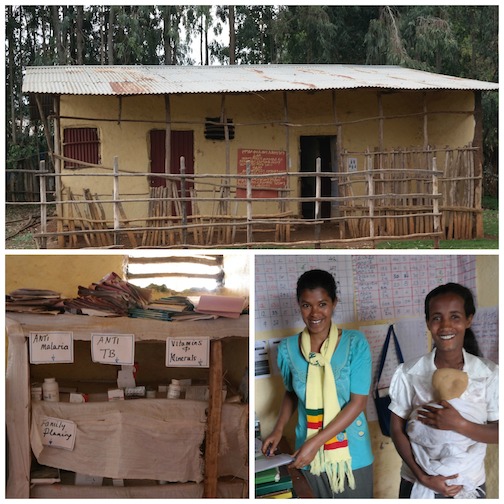
The Mosebo Health Post and Health Extension Workers
We had met Tirgno and Fasika, the two Health Extension Workers at the Mosebo Health Post earlier that day as they showed us the two room interior, and explained their role in improving maternal and newborn health. They work to raise awareness in the community about the importance of antenatal care, and the potential dangers of giving birth at home for both mother and child. Newborn health is interdependent with maternal health, and the most prevalent causes of newborn mortality, infection, Asphyxiation, pre-maturity or low birth weight, and diarrhea can often be avoided with proper care. These days in Mosebo after receiving antenatal care at the Health Post women are then referred to the regional Health Center for deliveries.
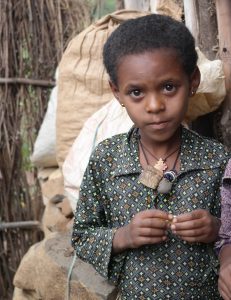
Zina shyly smiled when we ask her how she felt about having a new sibling, she stood straight and tall listening intently as we asked her mother about the babies’ arrival. When Mebrate goes into labor this time, with her second child, she will embark on the walk along rural dirt roads for around an hour to the nearest Health Center to give birth.
Elizabeth Atalay is reporting from Ethiopia as a fellow with the International Reporting Project (IRP). This is an original post written for World Moms Blog.
You can follow all IRP reports by World Moms Elizabeth Atalay & Nicole Melancon at #EthiopiaNewborns

Elizabeth Atalay is a Digital Media Producer, Managing Editor at World Moms Network, and a Social Media Manager. She was a 2015 United Nations Foundation Social Good Fellow, and traveled to Ethiopia as an International Reporting Project New Media Fellow to report on newborn health in 2014. On her personal blog, Documama.org, she uses digital media as a new medium for her background as a documentarian. After having worked on Feature Films and Television series for FOX, NBC, MGM, Columbia Pictures, Warner Brothers, 20th Century Fox, and Castle Rock Pictures, she studied documentary filmmaking and anthropology earning a Masters degree in Media Studies from The New School in New York. Since becoming a Digital Media Producer she has worked on social media campaigns for non-profits such as Save The Children, WaterAid, ONE.org, UNICEF, United Nations Foundation, Edesia, World Pulse, American Heart Association, and The Gates Foundation. Her writing has also been featured on ONE.org, Johnson & Johnson’s BabyCenter.com, EnoughProject.org, GaviAlliance.org, and Worldmomsnetwork.com. Elizabeth has traveled to 70 countries around the world, most recently to Haiti with Artisan Business Network to visit artisans in partnership with Macy’s Heart of Haiti line, which provides sustainable income to Haitian artisans. Elizabeth lives in New England with her husband and four children.
More Posts

by Susie Newday (Israel) | Jun 18, 2014 | 2014, Awareness, Guest Post, Israel, Kids, Media, Motherhood, Parenting, Safety, Terrorism, World Voice
Below is a guest post by Joanna Landau, the founder of Kinetis. I turned to her when I was struggling to write a post about 3 teenagers kidnapped in Israel by terrorists. I knew I wanted to bring attention to the situation because I have been appalled at the lack of press this situation was getting around the world. Fellow World Moms confirmed for me that in their respective countries, the news was getting close to no coverage and in many instances, no coverage at all. Yet here in Israel, no one has thought about anything else for the past 6 days. Joanna has managed to capture all my thoughts and feelings. Please share her message.
The phone rings. “Hey, Mom, it’s me”, your 16 year old son says, “I’m on my way home”. You put the phone down, and go back to whatever it is you’re doing. An hour later, you start to worry, he’s not answering his phone. Two hours later you and your husband start to panic, you call friends, relatives, start canvassing the neighborhood. Three, four, five hours later, you know something’s happened. And then you realize you’ve joined that awful statistic, something’s happened. Turns out your son hitchhiked his way home with a couple of friends, and has been kidnapped. Your worst fears have come true. And now what? What would you do to bring him back, assuming the police are doing everything they can to find him?
There’s a boy called Naftali, and he was kidnapped together with his friends Gilad and Eyal 6 days ago. Naftali called his mother, a half an hour before he got into the car.
This is not a hypothetical situation. It happened in Israel and you may have not heard of it, because it sounds like the kind of thing that can happen in a place where there’s a conflict going on.
And some may put a political twist on it, bringing in all sorts of issues that can cloud the basic, simple fact that three youngsters have been kidnapped.
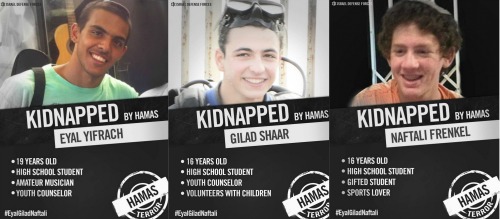
In Israel it’s the only thing on our mind, as a nation fears for three kids, not soldiers, who have disappeared, apparently taken by terrorists. But it’s not a political story: for every mother, wherever you live, it’s a personal story. Because these things can happen anywhere, and children and teens have become innocent victims of the evils of this world.
In America it may be from a shooting spree at a school, in Nigeria it’s girls at a boarding school. In any country, it may be a bitter divorced parent who takes their kids without telling the ex-spouse; or it can be a sick person who preys on children. Kidnapping can be anywhere, it can happen to anyone.
Gilad, 16 years old, likes to bake and volunteers with youth his age. Apparently, when he steps into a room, his smile lights it up. Naftali plays the guitar, loves football and is an excellent student. Eyal is 19, likes to sing, and sang at his cousin’s wedding not long ago. These are kids, just like yours. They don’t represent the state, they probably never imagined they would. But everyone is turning this into a political, or diplomatic discussion. It’s not. It’s about how fragile this world is and whether you care.
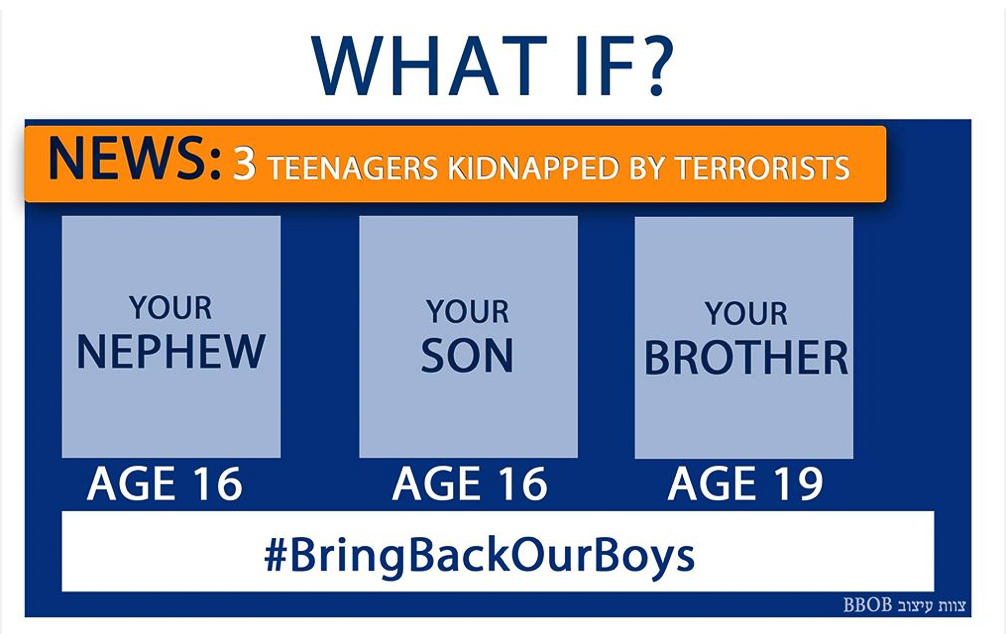
Imagine it was your kid who phoned 6 days ago. Imagine what you’d be feeling today, knowing he’s in the hands of merciless terrorists, or worse. I’m usually a very positive person, with an optimistic outlook on life and a constant desire to make the most of what we have. But as I look at my own three kids, who are 12, 10 and 7 and home safely with me, I wonder how Naftali, Gilad and Eyal’s parents must be feeling.
Premised on the #BringBackOurGirls campaign to raise awareness for the kidnapping of the Nigerian girls, a campaign to #BringBackOurBoys has also exploded online. But only in Israeli and Jewish circles, and hardly in traditional global media sources. Because everyone else is looking at this and just moving on.
If you’re a mother, and you understand how it feels to love your child, and if you believe that children, more than anyone, are innocent until proven guilty, you can’t and shouldn’t remain indifferent to this incident. If you have a 16 or 19 year old kid, hug them tonight, and if these words resonate with you, snap a quick selfie together and help the world #BringBackOurBoys .
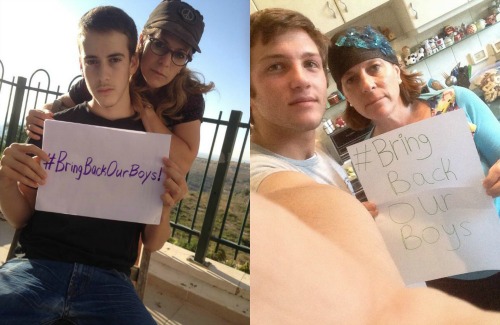 Photo Credit: Maya Ben-David & Avner Seliger
Photo Credit: Maya Ben-David & Avner Seliger
This was an original guest post for World Moms Blog by Joanna Landau.
Joanna Landau is the mother of 3 as well as the Founder & Executive Director of Kinetis, a non profit social startup promoting Israel as a hub of creativity and innovation. Kinetis brings leading bloggers from around the world to Israel to experience it for themselves. In addition, Kinetis operates educational programs in Israeli schools, the Army and Universities that aim to reignite national pride.
Susie Newday is a happily-married American-born Israeli mother of five. She is an oncology nurse, blogger and avid amateur photographer.
Most importantly, Susie is a happily married mother of five amazing kids from age 8-24 and soon to be a mother in law. (Which also makes her a chef, maid, tutor, chauffeur, launderer...) Susie's blog, New Day, New Lesson, is her attempt to help others and herself view the lessons life hands all of us in a positive light. She will also be the first to admit that blogging is great free therapy as well. Susie's hope for the world? Increasing kindness, tolerance and love.
You can also follow her Facebook page New Day, New Lesson where she posts her unique photos with quotes as well as gift ideas.
More Posts - Website
Follow Me:






by Nicole Melancon (USA) | Jun 17, 2014 | 2014, Ethiopia, Humanitarian, Maternal Health, Newborn Health, Save The Children, World Voice
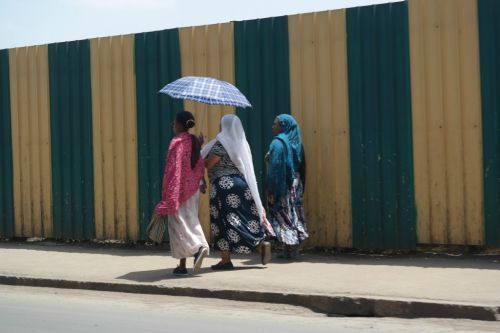
Ethiopia, one of the poorest countries in Africa with a population of 90 million people, stunned the world by achieving the Millennium Development Goal #4 of reducing the mortality rates of children under age 5 by two-thirds well ahead of the 2015 deadline. In a country in which 95% of the population lives outside of an urban center in rural, remote and hard to reach areas and a shocking 80% of women birth at home without a midwife. Health Extension Workers (HEW) have been the key ingredient to Ethiopia’s success. However, sadly the rate of newborn survival in Ethiopia has not shown nearly as much progress.
As an international reporting fellow with The International Reporting Project, fellow World Moms Blog editor, Elizabeth Atalay, and I are in Ethiopia for the next two weeks reporting on newborn health. We will be meeting with a diverse variety of people around the country such as doctors, health officials, mothers, NGOs, midwives and health extension workers to learn about Ethiopia’s maternal, newborn and child health systems, policies and strategies for improving newborn health. Today we had a presentation on maternal, newborn and child health in Ethiopia given by Dr. Abeba Bekele, the Program Manager at Save the Children Ethiopia’s Saving Newborn Lives Program.
Dr. Abeba Bekele is a medical doctor by training yet after spending five years working in the field she saw firsthand some of the tragic problems with maternal care in her country.
Watching as a patient bled to death after delivery, and being unable to save this mother of six, was a turning point for Dr. Abeba. She decided to move to working in public health policy in hope of improving Ethiopia’s poor maternal and child health care system.
Over the years, Dr. Abeba has seen remarkable progress in some areas, but painfully slow progress in other areas in regards to maternal, newborn and child health.
- Over the past 20 years, Ethiopia has reduced child deaths (for children under age 5) by more than two-thirds. In 1990, an estimated 204 children in every 1,000 in Ethiopia died before the age of five. Now that number is closer to 69 in every 1,000.
- While 1- 59 months (i.e. 5 year) child mortality rate is declining 6.1% annually the neonatal rate (first 28 days of life) is only declining 2.4% annually.
- Since the year 2000, Ethiopia has reduced its lifetime risk of maternal death from 1 in 24 to 1 in 67.
Although these figures are encouraging, there is also much work to be done in improving maternal, newborn and child health in Ethiopia. One of the main issues that is making maternal and newborn mortality rates difficult to tackle is the fact that over 80% of women in Ethiopia deliver at home with no trained help. These women give birth assisted by the community birth attendant, with a friend, a neighbor or even by themselves. The best way to save both maternal and newborn lives is to have women give birth assisted by a trained midwife at a health center. In fact the Ethiopian government is strongly encouraging all women to give birth at a health center but there are many obstacles in the way.
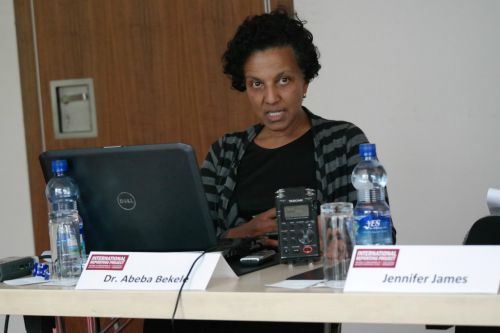
In an effort to improve maternal, newborn and child health, the Ethiopian government has implemented a massive effort of new policies and programs throughout the nation. The biggest success story has been the training and deploying of an army of 34,000 Health Extension Workers (HEW). Implemented in 2005, this massive effort has had remarkable success in saving lives through education, prevention of diseases, and provision of family health services. HEW’s live within the community and are trained and paid by the government to do home visits for an assigned population within their community. HEWs have been successful in cutting child under five deaths significantly as they can check and treat for the biggest child killers like diarrhea, pneumonia and malaria. However, HEWs are not trained as midwives, and can only advise a woman to give birth in a health center. This is an area that must be changed as giving birth by a trained professional in a health center would significantly reduce neonatal and maternal deaths.
Progress also needs to be made in the sheer accessibility and number of health centers. Today there are only 3,500 health centers in Ethiopia for 90 million people. More health centers and hospitals need to be built and more roads to reach the inaccessible areas. More midwives need to be trained and distributed throughout the country. According to the 2012 State of the World’s Midwives report, there is one midwife for every 18,000 people in Ethiopia whereas the World Health Organization recommends there should be one midwife per every 5,000 people in a given country. A lot of work needs to be done but the progress they have made in the past two decades is admirable.
Nicole Melancon is reporting from Ethiopia as a fellow with the International Reporting Project (IRP). This is an original post written for World Moms Blog.
You can follow all IRP reports by World Moms Elizabeth Atalay & Nicole Melancon at #EthiopiaNewborns

Third Eye Mom is a stay-at-home mom living in Minneapolis, Minnesota with her two children Max (6) and Sophia (4). Her children keep her continually busy and she is constantly amazed by the imagination, energy and joy of life that they possess! A world wanderer at heart, she has also been fortunate to have visited over 30 countries by either traveling, working, studying or volunteering and she continues to keep on the traveling path.
A graduate of French and International Relations from the University of Wisconsin Madison, where she met her husband Paul, she has always been a Midwest gal living in Minnesota, Wisconsin and Chicago. This adventurous mom loves to be outside doing anything athletic (hiking, running, biking, skiing, snowshoeing or simply enjoying nature), to travel and volunteer abroad, to write, and to spend time with her beloved family and friends.
Her latest venture involves her dream to raise enough money on her own to build and open a brand-new school in rural Nepal, and to teach her children to live compassionately, open-minded lives that understand different cultures and the importance of giving back to those in need. Third Eye Mom believes strongly in the value of making a difference in the world, no matter how small it may be. If there is a will, there is a way, and that anything is possible (as long as you set your heart and mind to it!).
Visit her on her blog, Thirdeyemom, where she writes about her travels and experiences in other lands!
More Posts

































